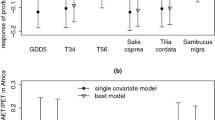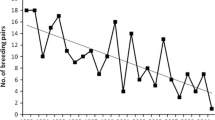Abstract
There is an urgent need to understand how climate change will impact on demographic parameters of vulnerable species. Migrants are regarded as particularly vulnerable to climate change; phenological mismatch has resulted in the local decline of one passerine, whilst variations in the survival of others have been related to African weather conditions. However, there have been few demographic studies on trans-Saharan non-passerine migrants, despite these showing stronger declines across Europe than passerines. We therefore analyse the effects of climate on the survival and productivity of common sandpipers Actitis hypoleucos, a declining non-passerine long-distant migrant using 28 years’ data from the Peak District, England. Adult survival rates were significantly negatively correlated with winter North Atlantic Oscillation (NAO), being lower when winters were warm and wet in western Europe and cool and dry in northwest Africa. Annual variation in the productivity of the population was positively correlated with June temperature, but not with an index of phenological mismatch. The 59% population decline appears largely to have been driven by reductions in adult survival, with local productivity poorly correlated with subsequent population change, suggesting a low degree of natal philopatry. Winter NAO was not significantly correlated with adult survival rates in a second, Scottish Borders population, studied for 12 years. Variation in climatic conditions alone does not therefore appear to be responsible for common sandpiper declines. Unlike some passerine migrants, there was no evidence for climate-driven reductions in productivity, although the apparent importance of immigration in determining local recruitment complicates the assessment of productivity effects. We suggest that further studies to diagnose common sandpiper declines should focus on changes in the condition of migratory stop-over or wintering locations. Where possible, these analyses should be repeated for other declining migrants.




Similar content being viewed by others

References
Anders AD, Post E (2006) Distribution-wide effects of climate on population densities of a declining migratory landbird. J Anim Ecol 75:221–227
Baillie SR, Marchant JH, Crick HQP, Noble DG, Balmer DE, Coombes RH, Downie IS, Freeman SN, Joys AC, Leech DI, Raven MJ, Robinson RA, Thewlis RM (2006) Breeding birds in the wider countryside: their conservation status 2005. BTO research report no. 435. BTO, Thetford (http://www.bto.org/birdtrends)
Beale CM, Burfield IJ, Sim IMW, Rebecca GW, Pearce-Higgins JW, Grant MC (2006) Climate change may account for the decline in British ring ouzels Turdus torquatus. J Anim Ecol 75:826–835
Both C, Bouwhuis S, Lessells CM, Visser ME (2006a) Climate change and population declines in a long-distance migratory birds. Nature 441:81–83
Both C, Sanz JJ, Artemyev AA, Blaauw B, Cowie RJ, Dekhuijzen AJ, Enemar A, Järvinen A, Nyholm NEI, Potti J, Ravussin P-A, Silverin B, Slater FM, Sokolov LV, Visser ME, Winkel W, Wright J, Zang H (2006b) Pied flycatchers Ficedula hypoleuca traveling from Africa to breed in Europe: differential effects of winter and migratory conditions on breeding data. Ardea 94:511–525
Brunel T, Boucher J (2007) Long-term trends in fish recruitment in the north-east Atlantic related to climate change. Fish Oceanogr 16:336–349
Burnham KP, Anderson DR (2002) Model selection and inference: a practical information—theoretic approach. Fort Collins, Colorado
Coppack T, Both C (2002) Predicting life-cycle adaptation of migratory birds to global climate change. Ardea 90:369–378
Cowley E, Siriwardena GM (2005) Long-term variation in survival rates of Sand Martins Riparia riparia: dependence on breeding and wintering ground weather, age and sex, and their population consequences. Bird Study 52:237–251
Cramp S, Simmons KEL (1983) Handbook of the birds of Europe, the Middle East and North Africa: the birds of the Western Palearctic. Waders to gulls, vol 3. Oxford University Press, Oxford
Dougall TW, Holland PK, Mee A, Yalden DW (2005) Comparative population dynamics of common sandpipers Actitis hypoleucos: living at the edge. Bird Study 52:80–87
Dugger KM, Faaborg J, Arendt WJ, Hobson KA (2004) Understanding survival and abundance of overwintering warblers: does rainfall matter? Condor 106:744–760
Durance I, Ormerod SJ (2007) Climate change effects on upland stream macroinvertebrates over a 25-year period. Glob Chang Biol 13:942–957
Fischlin A, Midgley GF, Price JT, Leemans R, Gopal B, Turley C, Rounsevell MDA, Dube OP, Tarazona J, Velichko AA (2007) Ecosystems, their properties, goods, and services. In: Parry ML, Canziani OF, Palutikof JP, van der Linden PJ, Hanson CE (eds) Climate change 2007: impacts, adaptation and vulnerability. Contribution of Working Group II to the fourth assessment report of the Intergovernmental Panel on Climate Change. Cambridge University Press, Cambridge, pp 211–272
Forchhammer MC, Post E, Stenseth NC (1998) Breeding phenology and climate. Nature 319:29–30
Forchhammer MC, Clutton-Brock TH, Lindström J, Albon SD (2001) Climate and population density induce long-term cohort variation in a northern ungulate. J Anim Ecol 70:721–729
Forchhammer MC, Post E, Stenseth NC (2002) North Atlantic Oscillation timing of long- and short-distance migration. J Anim Ecol 71:1002–1014
Freckleton RP, Watkinson AR, Green RE, Sutherland WJ (2006) Census error and the detection of density dependence. J Anim Ecol 75:837–851
Greene CH, Pershing AJ (2004) Climate and the conservation biology of North Atlantic right whales: the right whale at the wrong time? Front Ecol Environ 2:29–34
Hallett TB, Coulson T, Pilkington RG, Clutton-Brock TH, Pemberton JM, Grenffell B (2004) Why large-scale climate indices seem to predict ecological processes better than local weather. Nature 430:71–75
Hitchcock CL, Gratto-Trevor C (1997) Diagnosing a shorebird local population decline with a stage-structured population model. Ecology 78:522–534
Holland PK, Yalden DW (1991) Population dynamics of common sandpipers Actitis hypoleucos breeding along an upland river system. Bird Study 38:151–159
Holland PK, Yalden DW (1995) Who lives and who dies? The impact of severe April weather on breeding common sandpipers Actitis hypoleucos. Ring Migr 16:121–123
Holland PK, Yalden DW (2002a) Population dynamics of common sandpipers Actitis hypoleucos in the Peak District of Derbyshire—a different decade. Bird Study 49:131–138
Holland PK, Yalden DW (2002b) Common sandpiper, Actitis hypoleucos. In: Wernham C, Thoms M, Marchant J, Clark J, Siriwardena G, Baillie S (eds) The migration atlas. Poyser, London, pp 379–391
Hüppop O, Hüppop K (2003) North Atlantic Oscillation and timing of spring migration in birds. Proc R Soc Lond B 270:233–240
Hurrell JW, Kushnir Y, Visbeck M (2001) The North Atlantic Oscillation. Science 291:603–604
Hurrell KW, Kushnir Y, Ottersen G, Visbeck M (2003) An overview of the North Atlantic Oscillation. Geophys Monogr 134:1–35
Jackson DB (1994) Breeding dispersal and site-fidelity in three monogamous wader species in the Western Isles, UK. Ibis 136:463–473
Janicot S, Trzaska S, Poccard I (2001) Summer Sahel–ENSO teleconnection and decadal time scale SST variations. Climate Dynamics 18:303–320
Lampila S, Orell M, Belda E, Koivula K (2006) Importance of adult survival, local recruitment and immigration in a declining boreal forest passerine, the willow tit Parus motanus. Oecologia 148:405–413
Lemoine N, Böhning-Gaese K (2003) Potential impact of global climate change on species richness of long-distance migrants. Conserv Biol 17:577–586
Ludwig GX, Alatalo RV, Helle P, Linden H, Lindstrom J, Siitari H (2006) Short- and long-term population dynamical consequences of asymmetric climate change in black grouse. Proc R Soc Lond B 273:2009–2016
Mee A (2001) Reproductive strategies in the common sandpiper Actitis hyploeucos. PhD thesis, University of Sheffield, UK
Mills AM (2005) Changes in the timing of spring and autumn migration in North American migrant passerines during a period of global warming. Ibis 147:259–269
Newton I (1998) Population limitation in birds. Academic Press, London
Newton I (2004) Population limitation in migrants. Ibis 146:197–226
Oberhauser K, Townsend Peterson A (2003) Modelling current and future potential wintering distributions of eastern North American monarch butterflies. Proc Natl Acad Sci USA 100:14063–14068
Parmesan C, Yohe G (2003) A globally coherent fingerprint of climate change impacts across natural systems. Nature 421:37–42
Peach W, Baillie S, Underhill L (1991) Survival of British sedge warblers Acrocephalus schoenobaenus in relation to west African rainfall. Ibis 133:300–305
Post E, Stenseth NC, Langvatn R, Fromentin J-M (1997) Global climate change and phenotypic variation among red deer cohorts. Proc R Soc Lond B 264:1317–1324
Pradel R, Hines JE, Lebreton JD, Nichols JD (1997) Capture–recapture survival models taking account of transients. Biometrics 53:60–72
Pradel R, Wintrebert CMA, Gimenez O (2003) A proposal for a goodness-of-fit test to the Arnason–Schwarz multisite capture–recapture model. Biometrics 59:43–52
Reid JM, Bignal EM, McCracken DI, Monaghan P (2003) Environmental variability, life-history covariation and cohort effects in the red-billed chough Pyrrhocorax pyrrhocorax. J Anim Ecol 72:36–46
Rodriguez C, Bustamante J (2003) The effect of weather on lesser kestrel breeding success: can climate change explain historical population declines? J Anim Ecol 72:93–810
Root RJ, Price JT, Hall KR, Schneider SH, Rosenzweig C, Pounds JA (2003) Fingerprints of global warming on wild animals and plants. Nature 421:57–60
Sanderson FJ, Donald PF, Burfield IJ, van Bommel FPJ (2006) Long-term population declines in Afro-Palearctic migrant birds. Biol Conserv 131:93–105
Sillett TS, Holmes RT, Sherry TW (2000) Impacts of a global climate cycle on population dynamics of a migratory songbird. Science 288:2040–2042
Sparks TH, Bairlein F, Bojarinova JG, Hüppop O, Lehikoinen EA, Rainio K, Sokolov LV, Walker D (2005) Examining the total arrival distribution of migratory birds. Glob Chang Biol 11:22–30
Stenseth NC, Mysterud A (2005) Weather packages: finding the right scale and composition of climate in ecology. J Anim Ecol 74:1196–1198
Stige LC, Stave J, Chan KS, Ciannelli L, Pettorelli N, Glantz M, Herren HR, Stenseth NC (2006) The effect of climate variation on agro-pastoral production in Africa. Proc Natl Acad Sci USA 103:3049–3053
Stokke BG, Moller AP, Saether B-E, Rheinwald G, Gutscher H (2005) Weather in the breeding area and during migration affects the demography of a small long-distance passerine migrant. Auk 122:637–647
Thomas CD, Cameron A, Green RE, Bakkenes M, Beaumont LJ, Collingham YC, Erasmus BFN, Ferreira de Siqueira M, Grainger A, Hannah L, Hughes L, Huntley B, van Jaarsveld AS, Midgley GF, Miles L, Ortega-Huerta MA, Peterson AT, Phillips OL, Williams SE (2004) Extinction risk from climate change. Nature 427:145–148
Thompson PS, Baines D, Coulson JC, Longrigg G (1994) Age at first breeding, philopatry and breeding site-fidelity in the lapwing Vanellus vanellus. Ibis 136:474–484
Vahatalo AV, Rainio K, Lehikoinen A, Lehikoinen E (2004) Spring arrival of birds depends on the North Atlantic Oscillation. J Avian Biol 35:210–216
Visser ME, Both C (2005) Shifts in phenology due to global climate change: the need for a yardstick. Proc R Soc Lond B 272:2561–2569
Wang D, Wang C, Yang X, Lu J (2005) Winter Northern Hemisphere surface air temperature variability associated with the Arctic Oscillation and North Atlantic Oscillation. Geophys Res Lett 32:L16706. doi:10.1029/2005GL022952
Ward MP (2005) The role of immigration in the decline of an isolated migratory bird population. Conserv Biol 19:1528–1536
White GC (2001) Program MARK, version 2.1: mark and recapture survival rate estimation. http://www.cnr.colstate.edu/~gwhite/mark Accessed 15 October 2001
White GC, Burnham KP (1999) Program MARK: survival estimation from populations of marked animals. Bird Study 46:S120–S138
Yalden DW (1986) Diet, food availability and habitat selection of breeding common sandpipers Actitis hypoleucos. Ibis 128:23–36
Acknowledgements
We are grateful to the many landowners who allowed us to conduct this fieldwork, including Blackhope, Raeshaw and Rosebery Estates (Borders), M. Cotterill, G. Wainright, L. Hassel, Severn-Trent Water and the National Trust (Peak District). We are also grateful to Adam Batty, Lynn Campbell, Alan Lauder, Tony O’Connor, Trevor Smith and Bill Underwood for their assistance in the field, and to Phil Holland for his long involvement with the Ashop study. We are grateful for many helpful comments from two anonymous referees and Katrin Böhning-Gaese. This study fully complied with current UK laws.
Author information
Authors and Affiliations
Corresponding author
Additional information
Communicated by Katrin Böhning-Gaese.
Rights and permissions
About this article
Cite this article
Pearce-Higgins, J.W., Yalden, D.W., Dougall, T.W. et al. Does climate change explain the decline of a trans-Saharan Afro-Palaearctic migrant?. Oecologia 159, 649–659 (2009). https://doi.org/10.1007/s00442-008-1242-4
Received:
Accepted:
Published:
Issue Date:
DOI: https://doi.org/10.1007/s00442-008-1242-4



